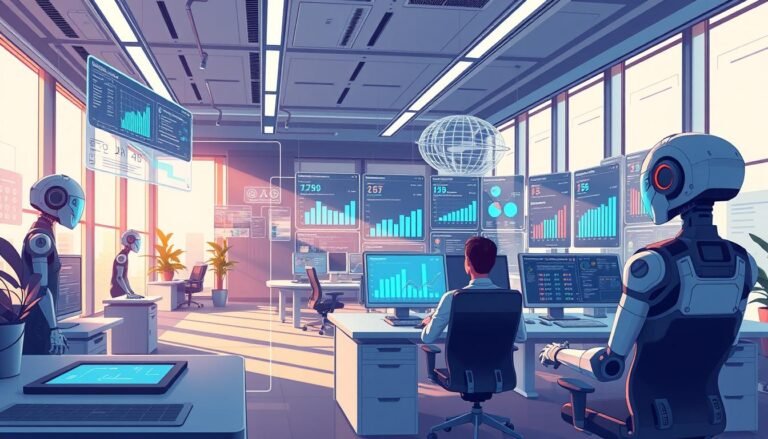Smart Cities – Strategic Planning for Urban Innovation
Did you know that investing in public transport and bike paths can cut city carbon emissions by 5-15%? As cities grow, smart cities become key to solving these issues. They make life better with new solutions. This guide shows how tech and city planning work together for a better future.
Over half the world lives in cities now, and they must change and grow. This means tackling current problems and planning for a digital future. By mixing physical and tech solutions, cities are getting better for everyone. Smart cities use data and tech to make cities more efficient and green.
Key Takeaways
- Smart cities rely on strategic planning to tackle urban challenges.
- Integrating technology into infrastructure creates improved urban living conditions.
- Investment in sustainable initiatives can significantly reduce urban carbon footprints.
- Data analytics plays a critical role in smart city decision-making processes.
- The future of cities hinges on balancing physical and digital resources for sustainability.
Understanding Smart Cities: A New Urban Paradigm
Smart cities are changing the way we live, using technology to make life better. They focus on growing the economy and improving life for everyone. These cities use technology to solve big problems like climate change and how we use resources.
They aim for a better future by making things work together better and using data to make smart choices. This approach helps cities grow in a way that’s good for the planet.
Definition and Core Characteristics
Smart cities use new technology to plan and manage better. They are key to solving big issues like climate change and using resources wisely. These cities have some key features that make them stand out.
- Digital infrastructure integration: They use connected systems for things like energy and transport.
- Data-driven decision-making: Cities use tech to make better decisions and improve services for people.
- Sustainability: They focus on being green and reducing harm to the environment.
- Enhancing public participation: People get more involved in city decisions with data and tools.
How Smart Cities Leverage Technology for Urban Living
Today’s cities use many technologies to make life easier. Things like IoT devices and sensors help manage traffic and waste. This focus on tech also brings new economic chances, making cities centers of innovation.
Experts and groups keep updating what makes a city “smart.” They link it to smart industries, people, and how cities are run.
Importance of Strategic Urban Planning
Strategic urban planning is key to tackling the big challenges cities face today. Cities deal with traffic jams, pollution, and poor public services. With smart city plans, these problems can turn into chances for better living.
Smart city projects use data to make decisions and focus on green solutions. This makes cities better places to live.
Addressing Urban Challenges Through Effective Planning
Good urban planning makes cities better for everyone. By planning carefully, cities can be places people love living in. This includes smart zoning, land use, and ways to move around.
Some key strategies are:
- Transit-oriented development that makes public transport easy to use.
- Adding green infrastructure like parks to clean the air.
- Using big data analytics to make smart choices.
The Role of Urban Planners in Smart City Development
Urban planners are crucial for smart cities. They make sure digital and physical parts work together. By using new tech like IoT and green energy, they create sustainable places.
Here are some ways they help:
- Creating mixed-use areas for a diverse community.
- Supporting smart energy systems to cut down on carbon emissions.
- Building fast internet networks for connected devices.
Smart Cities – Strategic Planning for Urban Innovation
Urban innovation is key to making cities smarter. It’s important to plan carefully, combining both physical and digital parts. This way, cities become better places to live and run more smoothly.
Key Strategies for Urban Innovation Solutions
There are a few main strategies for smart city success:
- Using data analytics to make better decisions.
- Smart grid technologies to manage energy use.
- High-speed broadband networks for better connectivity.
- Innovative waste management for a sustainable economy.
- Working together between IoT devices and city services.
Integrating Physical and Digital Infrastructure
A smart city needs both its physical and digital parts to work together well. This mix helps cities tackle big challenges, like:
- Smart monitoring for better use of resources.
- Public safety improved with IoT and real-time data.
- Lower costs with smart water management.
- Better transportation through shared data.
Technologies Driving Smart City Initiatives
Urban living is changing fast thanks to new technologies. These innovations are key for building smart cities and solving big city problems. They make cities run better, last longer, and improve life for everyone living there.
The Internet of Things (IoT) in Urban Management
The Internet of Things, or IoT, links devices in cities for real-time data. This helps with traffic and keeping an eye on the environment. For example, smart meters in Barcelona saved a lot of water.
By using IoT, city planners can manage services better and use resources wisely. This is part of the digital change making cities better.
Big Data Analytics for Enhanced Decision-Making
Big data analytics is crucial for city management. It gives leaders insights from lots of data. This helps make better decisions and improve city services.
With better data analysis, cities can tackle issues like inequality. This leads to more inclusive and sustainable cities.
Role of Artificial Intelligence in Smart Cities
Artificial Intelligence (AI) makes cities work better and engage with people more. AI looks at data to solve problems like keeping infrastructure in good shape. More cities are using AI to be more flexible and strong.
Sustainable Urbanism: A Cornerstone of Smart Cities
Sustainable urbanism is key for smart cities. It helps cities use less energy and be kinder to the planet. By 2050, 70% of people will live in cities, making it crucial to plan for the future.
Using green buildings and clean energy is important. It makes cities better for people and the planet. This means cleaner air and a healthier place to live.
Green Infrastructure and Its Benefits
Green infrastructure includes parks and green roofs. These things make cities better for people and the environment. They help fight the heat island effect and make air cleaner.
They also give people places to relax and enjoy nature. By adding these to city plans, cities can support more life and be healthier places to live.
Renewable Energy Solutions for Urban Environments
Cities like Austin are using more solar and wind power. They want to use 55% renewable energy by 2025. This helps cut down on carbon emissions and makes energy more reliable.
It also helps cities meet their goals for being sustainable. Using renewable energy is key to a green future.
Reducing Resource Consumption through Efficient Design
Designing cities better helps use less resources. Cities need to use smart traffic systems and manage energy well. This way, cities can use less energy and reduce their impact on the environment.
By focusing on these strategies, cities can be more sustainable. This is important for a greener future.
Challenges and Risks of Smart City Development
Smart city projects bring many challenges for urban planners. They use new tech to make cities better, but they face big issues with data privacy and security. They collect lots of data from smart devices, so they need strong security to keep it safe.
This need for strong data protection grows as cities get more digital. It shows the big tech challenges in making cities better.
Data Privacy and Security Concerns
Smart city projects have big risks from data breaches and privacy issues. Cities collect a lot of data to improve services, but they must keep it safe from hackers. This means spending a lot of money on security, which can be hard for cities.
Also, people need to trust these projects. If cities don’t share information openly and take responsibility, people might not want more tech in their lives.
Equitable Access to Smart City Benefits
Not everyone can use the benefits of smart cities equally. If some areas don’t get the same advantages, it could make things worse for those left out. Cities must make sure everyone gets better services and new tech.
To do this, cities can reach out to communities, offer cheap tech options, and make policies that include everyone in the planning. This way, all people can use the new tech and services.
Conclusion
Smart cities are changing the way we live, focusing on planning and innovation. They use new tech like the Internet of Things (IoT), artificial intelligence (AI), and 5G to make cities better. These cities work on being sustainable, productive, and places where people want to live.
They also aim to improve city operations and meet the needs of everyone involved through better data sharing and services.
Urban development strategies are key to solving the problems cities face today. Urban planners are crucial in making smart cities by thinking about privacy, inclusivity, and getting the community involved. Working together, planners, policymakers, and residents can make the most of what smart cities offer.
The future looks bright for cities with smart city plans. By using technology and working together, cities can become stronger, more appealing, and efficient. As we move forward, focusing on Smart Cities – Strategic Planning for Urban Innovation will help create a better future for everyone.
Source Links
- Urban future with a purpose
- Smart cities as a platform for technological and social innovation in productivity, sustainability, and livability: A conceptual framework
- Smart cities and innovative urban management: Perspectives of integrated technological solutions in urban environments
- Understanding ‘smart cities’_ Intertwining development drivers with desired outcomes in a multidimensional framework
- Crios 7-2014(def.).pdf
- Smart Cities: Innovations in Urban Planning and Infrastructure
- Smart Cities: Innovations in Urban Planning and Infrastructure
- Promoting Urban Innovation through Smart Cities: Evidence from a Quasi-Natural Experiment in China
- Developing Smart Cities: A Guide for City Leaders
- Smart Cities and Urbanisation
- Council Post: On The Horizon For Smart Cities: How AI And IoT Are Transforming Urban Living
- Thinking about becoming a smart city? 10 benefits of smart cities | Our Insights | Plante Moran
- The Smart City Cornerstone: Urban Efficiency
- Smart Sustainable Cities in the United States – Emerald Ecovations
- A Review on Key Innovation Challenges for Smart City Initiatives
- Challenges and Opportunities in Building Smart Cities
- Smart Cities: Integrating Technology, Community, and Nature
- Evolution of Smart Cities: Leveraging Technology for Urban Sustainability in 2024







